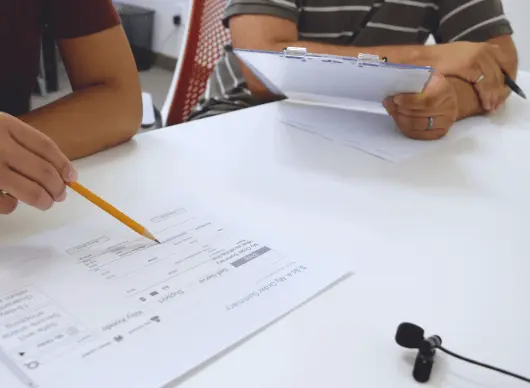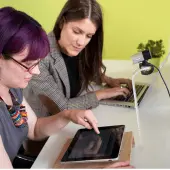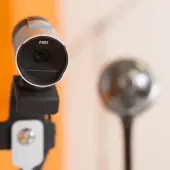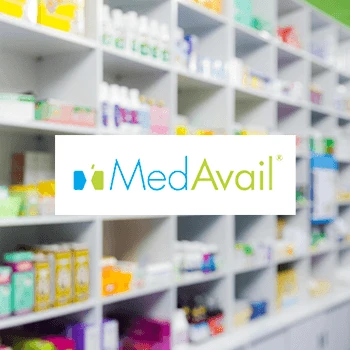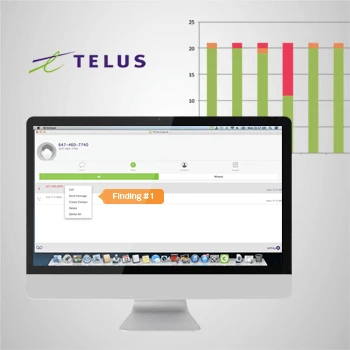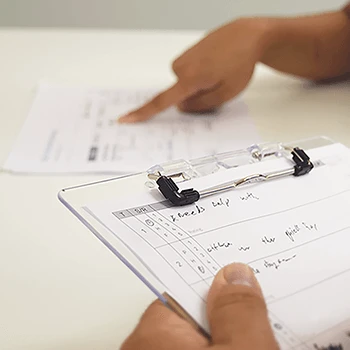What exactly is usability testing and why should we invest in it?
Usability testing systematically evaluates how well real users can interact with your product. It measures effectiveness (can users complete tasks), efficiency (how easily), and satisfaction (how users feel about the experience). This isn't opinion research—it's behavioral observation that identifies what works and what doesn't before you launch.
Tip: Choose testing partners who understand the difference between usability testing and public opinion research—they serve different purposes and require different methodologies.
How does usability testing fit into Experience Thinking?
Usability testing validates the product quadrant of Experience Thinking while informing the other three areas. It tests how users interact with your product features, reveals content effectiveness, exposes brand perception through user reactions, and identifies service touchpoints that need improvement. This creates a holistic view of your user experience.
Tip: Look for testing approaches that consider how product usability connects to your broader brand, content, and service experiences.
What's the difference between formative and summative usability testing?
Formative testing happens early in design to find and fix issues when changes are cost-effective. Users think aloud while completing tasks, revealing their mental models. Summative testing occurs later as quality assurance, measuring performance against defined criteria without hints or guidance. Both serve different purposes in the development process.
Tip: Plan for both types—formative testing saves money by catching issues early, while summative testing ensures your final product meets usability standards.
When should usability testing happen in our development process?
Testing should happen at least twice: early with wireframes or prototypes when design is malleable, and later with more functional versions. The best approach is testing early and often throughout development, not just at the end when fixes become expensive and disruptive.
Tip: Budget for iterative testing rather than one final test—early testing prevents costly late-stage changes.
How is usability testing different from user research or focus groups?
Usability testing observes actual user behavior through task completion, while focus groups collect opinions through discussion. User research is the broader category that includes usability testing as one method. Usability testing is task-based and behavioral, not conversational or opinion-based.
Tip: Use usability testing when you need to know 'how easy is this to use' rather than 'what do you think about this.'
What makes usability testing scientifically valid?
Valid usability testing follows systematic methods with representative participants, controlled conditions, and measurable criteria. It's a social science experiment that produces objective data about user performance, not subjective opinions. The methodology must be consistent and replicable to provide reliable insights.
Tip: Ensure your testing partner follows established usability testing standards and can explain their methodology clearly.
Can usability testing validate our product's market value?
No, usability testing measures how easy something is to use, not whether people want it or will buy it. With typically 8-18 participants in controlled settings, it can't validate market demand. Usability testing is diagnostic (what's wrong) not prescriptive (what the market wants).
Tip: Combine usability testing with market research and concept testing to get both usability and market validation.
What's your typical usability testing process?
We start by understanding your goals and users, then create testing protocols with realistic tasks. We recruit representative participants, conduct structured sessions with observation and measurement, analyze behavioral data, and provide actionable recommendations. The process focuses on identifying what works and what needs improvement.
Tip: Look for testing partners who can clearly explain how their process connects to your specific business objectives and user needs.
How do you recruit the right participants for usability testing?
Effective recruitment matches your actual user base through behavior-based criteria, not just demographics. We focus on relevant experience, technical comfort levels, and task contexts rather than age and gender alone. Representative participants ensure test results reflect real user challenges and capabilities.
Tip: Insist on recruitment criteria that reflect actual user behaviors and needs rather than generic demographic categories.
What's the ideal number of participants for usability testing?
For qualitative usability testing, 4-6 participants often reveal the most critical issues. This magic number balances insight quality with resource efficiency. For quantitative performance metrics, you need 15-20+ participants. The key is recruiting the right people rather than large numbers.
Tip: Focus on participant quality over quantity—the right 5 users provide more valuable insights than 50 wrong ones.
How long do usability testing sessions typically last?
Sessions usually run 60-90 minutes, allowing time for multiple tasks without user fatigue. This includes brief introductions, task completion, and post-test questions. Session length depends on task complexity and the number of features being tested.
Tip: Avoid sessions that are too short to gather meaningful insights or too long that participants become tired and less engaged.
What questions do you ask during usability testing?
We ask task-related questions that reveal thinking without leading users toward specific answers. Think-aloud protocols help us understand mental models. Post-task questions explore satisfaction and perceived difficulty. We avoid questions that turn usability testing into opinion research.
Tip: Choose testing partners who understand the difference between objective observation and subjective opinion gathering.
How do you handle bias in usability testing?
We minimize bias through neutral questioning, randomized task presentation, and objective observation protocols. Facilitators avoid leading questions and maintain professional distance. We focus on behavior rather than opinions, and clearly separate what users do from what they say.
Tip: Look for testing partners who can demonstrate specific techniques they use to maintain objectivity and reduce bias.
Can usability testing be conducted remotely?
Remote testing works well for many digital products and can access geographically distributed users. However, some products benefit from in-person observation, especially those requiring physical interaction or complex contexts. The choice depends on your product type and testing objectives.
Tip: Consider whether your product requires in-person observation or can be effectively tested through remote methods.
What different types of usability testing do you offer?
We offer formative testing for early design feedback, summative testing for quality assurance, comparative testing between design alternatives, and accessibility testing for diverse user needs. Each method serves specific purposes and stages in the development process.
Tip: Match the testing method to your current development stage and specific decision-making needs.
How detailed should our prototypes be for usability testing?
Prototype detail should match testing goals. For navigation testing, basic wireframes work well. For task completion testing, you need functional interactions. For content comprehension, realistic content is essential. Avoid both over-detailed prototypes and confusing placeholder content.
Tip: Focus prototype detail on the specific aspects you want to test rather than trying to perfect everything.
Can you test paper prototypes or early wireframes?
Yes, paper prototypes and wireframes are excellent for early testing. They're quick, cheap, and effective for testing basic task flows and information architecture. Users can interact with paper prototypes surprisingly well, and the low cost of failure makes iteration easy.
Tip: Don't let perfect be the enemy of good—early testing with simple prototypes prevents costly mistakes later.
How do you test complex user flows or multi-step processes?
Complex flows require careful task design and realistic scenarios. We create end-to-end tasks that mirror real user goals, test critical decision points, and identify where users get lost or confused. The focus is on the overall flow logic rather than individual screen details.
Tip: Test complete user journeys rather than individual screens to understand the full experience.
What's your approach to testing mobile apps versus websites?
Mobile testing considers touch interactions, screen size constraints, and usage contexts. We test on actual devices, account for different screen sizes, and consider one-handed usage patterns. Website testing focuses on different browsers, screen resolutions, and navigation patterns.
Tip: Test on the devices your users actually use, not just the platforms you prefer to design for.
How do you test accessibility and inclusive design?
Accessibility testing includes participants with diverse abilities and tests with assistive technologies. We evaluate compliance with accessibility standards while observing real user interactions. This approach identifies both technical compliance issues and practical usability barriers.
Tip: Include accessibility testing throughout development rather than retrofitting it at the end.
Can you test products that require specialized knowledge or training?
Yes, we test specialized products by recruiting participants with relevant expertise and creating realistic scenarios. This includes medical software, professional tools, and technical systems. The key is understanding the user's context and recruiting appropriate participants.
Tip: Ensure your testing partner understands your users' specialized context and can recruit appropriate participants.
How do you present usability testing results?
We create actionable reports that clearly identify issues, explain their impact, and provide prioritized recommendations. Results include user quotes, behavioral observations, and specific improvement suggestions. Reports are designed for easy communication to stakeholders and development teams.
Tip: Look for results presentations that provide clear priorities and actionable next steps, not just lists of issues.
What if testing reveals more issues than we can fix?
This is normal and expected. We help prioritize issues based on severity, frequency, and business impact. The goal isn't to find every possible problem but to identify the most critical ones that will improve user experience. Fix the top 5-10 issues, then test again.
Tip: Plan for iterative improvement rather than trying to fix everything at once.
How do you help translate findings into design solutions?
We provide specific improvement recommendations based on usability best practices and user behavior patterns. However, usability testing is diagnostic—it tells you what's wrong but doesn't automatically provide design solutions. We work with your team to interpret findings and develop solutions.
Tip: Choose testing partners who can help interpret results and work collaboratively with your design team.
What's the best way to communicate results to stakeholders?
We create stakeholder-appropriate presentations that connect usability findings to business impact. Executive summaries focus on user satisfaction and business metrics, while detailed reports provide specific guidance for designers and developers. Video clips of user struggles can be particularly compelling.
Tip: Frame usability issues in terms of business impact rather than just technical problems.
How do you measure the success of usability improvements?
Success is measured through follow-up testing that compares performance before and after changes. We track task completion rates, time to completion, error rates, and user satisfaction scores. The goal is demonstrable improvement in user experience metrics.
Tip: Plan for follow-up testing to validate that your improvements actually work.
What happens when stakeholders disagree with testing results?
Disagreements often stem from different perspectives on user needs versus business requirements. We help facilitate discussions that balance user feedback with business constraints. The key is using objective behavioral data to inform decisions rather than personal opinions.
Tip: Use disagreements as opportunities to dig deeper into user behavior and business requirements.
How do you ensure testing insights don't get lost over time?
We create documentation that captures not just what issues were found, but why they matter and how they connect to user goals. This includes design principles, decision rationale, and guidelines for future development. The goal is creating institutional knowledge that survives team changes.
Tip: Insist on documentation that explains the reasoning behind recommendations, not just the recommendations themselves.
How involved should our team be in usability testing?
Team involvement enhances both the testing process and implementation of results. We recommend having designers, developers, and key stakeholders observe sessions to build empathy for users. This first-hand exposure creates stronger commitment to addressing issues.
Tip: Include team members as observers to build understanding and buy-in for usability improvements.
What's the best way to prepare our team for usability testing?
Preparation includes setting clear expectations about what usability testing can and cannot reveal, establishing observation protocols, and defining roles during sessions. We brief teams on maintaining objectivity and separating user behavior from personal preferences.
Tip: Prepare your team to observe user behavior objectively rather than defending design decisions.
How do you handle situations where our team disagrees with user feedback?
Disagreements are normal and often productive. We facilitate discussions that explore why users struggled while considering business constraints and technical limitations. The goal is finding solutions that work for both users and business requirements.
Tip: Use disagreements as learning opportunities rather than battles to be won.
What skills should our internal team develop to support usability testing?
Internal teams benefit from developing user empathy, objective observation skills, and understanding of usability principles. This includes learning to separate personal preferences from user needs and understanding how to ask neutral questions that don't lead users.
Tip: Invest in training your team to think like users rather than just advocates for their design decisions.
How do you ensure our development team understands usability findings?
We create technical briefs that explain how usability issues translate into implementation requirements. Developers need to understand not just what to fix, but why it matters to users. This helps them make informed decisions when facing technical constraints.
Tip: Include developers in the testing process to help them understand user impact of technical decisions.
What's the best way to build internal usability testing capabilities?
Building internal capabilities requires training, tools, and ongoing support. We provide methodology training, help establish testing protocols, and create templates for consistent execution. The goal is enabling your team to conduct effective testing independently.
Tip: Start with guided practice sessions before attempting independent testing to ensure quality results.
How do you help align different teams around usability priorities?
Alignment comes from shared understanding of user needs and business impact. We facilitate workshops where different teams can discuss findings and collaborate on solutions. Clear prioritization based on user impact and business value helps teams focus their efforts.
Tip: Use usability findings to create shared language and priorities across different teams.
How do you structure investment for usability testing projects?
Investment reflects testing scope, participant requirements, and analysis depth. We work with you to define the right level of testing rigor based on your product complexity and decision-making needs. The investment should align with the potential cost of launching an unusable product.
Tip: Consider the cost of usability testing against the expense of support calls, user abandonment, and redesign work.
What factors influence usability testing timelines?
Timeline depends on participant recruitment, number of testing sessions, prototype complexity, and analysis depth. Recruitment often determines overall timeline, especially for specialized user groups. Simple tests can be completed in 2-3 weeks, while complex studies may take 4-6 weeks.
Tip: Start participant recruitment early to avoid timeline delays, particularly for specialized user segments.
How do you prioritize what to test when resources are limited?
When resources are limited, focus on testing the most critical user tasks and highest-risk areas of your product. Test features that are hardest to change after launch or that have the biggest impact on user success. Quality over quantity is key.
Tip: Test the features that would be most expensive to fix after launch rather than trying to test everything.
What's the return on investment for usability testing?
ROI comes from prevented costs: reduced support calls, lower user abandonment, faster development cycles, and improved user satisfaction. Every usability issue found and fixed during testing prevents multiple support incidents and frustrated users after launch.
Tip: Calculate ROI based on support cost reduction and user retention improvement, not just testing costs.
How do you fit usability testing into agile development processes?
Agile usability testing requires streamlined processes that fit sprint cycles. We use rapid testing methods, smaller participant groups, and focused testing questions. The key is maintaining testing quality while respecting agile timelines and iteration cycles.
Tip: Plan testing sprints that align with your development cycles and decision-making needs.
What's the minimum viable approach to usability testing?
A minimum approach might test 2-3 critical tasks with 4-5 participants using simple prototypes. This can provide directional guidance without major resource investment. The key is focusing on your biggest usability concerns rather than trying to test everything.
Tip: Start with focused testing of your biggest usability uncertainty rather than trying to test everything at once.
How do you ensure usability testing delivers actionable results?
Actionable results require clear testing objectives, appropriate participant selection, and analysis that connects to specific improvements. We ensure testing questions align with decisions you need to make and present results in formats that enable immediate action.
Tip: Define your decision-making criteria before testing to ensure results will be directly actionable.
How is AI changing usability testing approaches?
AI is enhancing usability testing through automated analysis of user behavior, pattern recognition in large datasets, and faster processing of video and audio data. However, AI cannot replace human insight in understanding user emotions, motivations, and context. The best approach combines AI efficiency with human empathy and interpretation.
Tip: Use AI tools to enhance testing efficiency and analysis, but maintain human expertise for interpreting user emotions and motivations.
What emerging technologies are impacting usability testing?
Eye tracking, biometric measurement, and advanced analytics are providing deeper insights into user behavior. However, these technologies supplement rather than replace traditional observation methods. The fundamental principle of watching real users interact with real products remains unchanged.
Tip: Evaluate whether new technologies truly improve your testing objectives or just add complexity.
What's your approach to testing personalized or adaptive interfaces?
Personalized interface testing requires understanding how different user types respond to adaptive features. We test with diverse user segments and evaluate how well interfaces adapt to different needs, preferences, and contexts over time.
Tip: Test personalized interfaces across different user types to understand adaptation effectiveness.
How do you stay current with evolving usability testing methodologies?
We continuously evaluate new testing tools, methodologies, and research findings while maintaining focus on proven principles. This includes staying informed about changes in user behavior, new interaction patterns, and emerging technologies that might impact usability.
Tip: Balance innovation in testing methods with proven approaches that deliver reliable insights.
What's the future of usability testing in product development?
The future involves more integrated testing throughout development, better tools for rapid iteration, and deeper integration with user analytics. However, the core need for observing real users interact with real products will remain central to successful product development.
Tip: Focus on building usability testing capabilities that can evolve with new tools while maintaining core research principles.
How do you ensure usability testing evolves with changing user expectations?
User expectations continuously evolve with new technologies and interaction patterns. We monitor these changes through ongoing research, industry analysis, and observation of emerging usage patterns. This ensures our testing approaches remain relevant to current user expectations.
Tip: Regularly reassess your testing assumptions to ensure they reflect current user expectations and behaviors.
